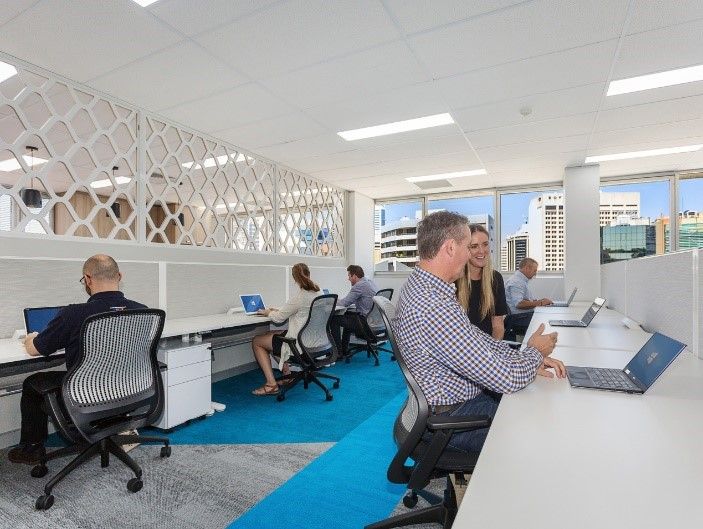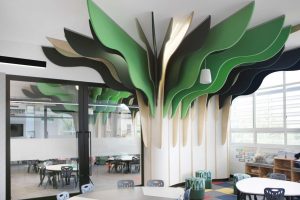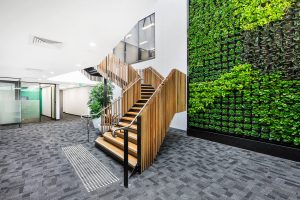“Open-plan offices don’t work” – a blanket statement that smothers logic
If the internet was a human with human characteristics, you could safely say that one of its most negative would be its love of spreading gossip and cherry-picking facts. A single statement or opinion can spread like wildfire over a period of days, either causing an uproar or attracting scrutiny only to disappear as quickly as it rose to prominence. In our industry, the latest casualty of this (fleeting) mass effect is the open-plan office.
It’s been widely asserted that open-plan offices are counterproductive and a failure in design. Depending on your appetite for outrage, you can read articles that portray them as anything from inconvenient to a force of evil sent to bring down companies from the inside using distraction and noise pollution. Some suggest that they are at best a paradox – promising increased collaboration while employees are encouraged to retreat into their own worlds, relying on email and messaging in order to communicate.
The main issue with these claims is that they treat all open-plan offices equally. This style of workplace CAN fail and destroy what it’s said to promote – if poorly designed or implemented for the wrong reasons, but this isn’t new news. There’s never been a one-size-fits-all approach to successful commercial interior design and there never will be. Examining such a complex topic in black and white does it a considerable disservice, so it’s important we locate, explore and emphasise an entire spectrum of grey that often goes ignored.
Does the head agree with the heart?
Function versus culture. This is an important point.
Before we get into the design specifics of a successful open-plan office, we need to talk about identity. If you were to decide to fit out your new (or rebuild your existing) workplace with an open-plan design, it’s imperative that you figure out whether it aligns with your existing company culture. A law firm that relies on sensitive client interactions would be out of its right mind to even consider an entirely open-plan arrangement. Similarly, if a company relies on telesales and is therefore defined by unrelenting conversation, then partitions are almost always going to be necessary.

Your workplace doesn’t dictate your company culture, your company culture dictates your workplace. When you ignore your company identity, culture and function and implement a stock-standard, open-plan office purely because everyone else is doing it, then there’s a fair chance it will fail.
Your employees are an invaluable resource
Side note: A logical extension of this meaningful decision-making is to take the temperature of your employees before making any moves. If your company has never before adopted an open-plan setting and the day-to-day is running exactly as desired, then change for the sake of change won’t help anyone. Taking into account the opinions and experiences of your employees is as sensible as it is important as they’re the ones who’ll be using the space – and if 99% swear that open-plan will directly interfere with the quality of their work, then you should at least be aware of that fact before proceeding.
When open-plan offices don’t work
We can say the following with complete confidence and pride: every single time we’ve worked with a client and come to the mutual decision that a form of open-plan is their best option, the results have been universally successful. In other words, we’re yet to encounter a single client whose company could benefit from open-plan, that hasn’t benefited from open-plan. This is because we only ever proceed with open-plan if it fits the company culture and helps fulfil the desired functionality. It also helps that our decision-making is based on experience, expertise and time-tested protocols. The key is to talk through everything.
Layout of the land
In many of the cases where open-plan offices haven’t worked, a number of factors have been overlooked when it comes to designing the layout.
Size of the space vs number of employees
Firstly, the size of the space vs the number of employees. If the dimensions don’t allow each member of staff adequate personal space —enough to feel free of spatial constraints — then implementing open-plan is doing them a disservice. Nobody wants to end up sitting shoulder-to-shoulder in a cramped space, treading on their co-worker’s (literal and figurative) toes. In order to maintain or boost performance (and sanity), people need their own personal space. That’s a given.

Each department in its right place
The other factor to take into account is department activity. A successful open-plan office layout arranges the right departments in the right locations. Just as certain departments might require more continuous interaction and therefore make more noise, others might require more individual focus. Arranging these departments adjacently is only ever going to lead to dissatisfaction and/or disruption. Haphazard, poorly-considered layouts are one of the major reasons open-plan offices fail, but when the meaningful arrangement of departments is achieved, these undesirables become non-issues.
So, in short, consider:
- Personal space
- Company culture
- Space size vs employee numbers
- Arrangement of departments
- Proximity to communal breakout spaces
- Proximity to essential amenities
- Functional requirements (lighting, noise, equipment)
These points should be considered and revisited at every stage of discovery and conceptualisation.
Open-plan doesn’t mean one space
For those who have never entered an open-plan office and have heard the recent backlash, it’d be easy to picture a single room and a bunch of employees sandwiched together – the human equivalent of a chicken coop. You can’t blame the uninitiated for making this incorrect assumption as to laypeople, the intricacies of successful open-plan offices are largely foreign territory. In some ways we are all familiar with (and scarred by) images of antiquated typing pools, sweatshops and other less than desirable work environments we see in the media.
“Open-plan requires a thoughtful combination of both open and closed spaces.”
Flexibility is key
The truth is, successful open-plan offices aren’t merely giant rooms full of tables with co-workers toiling side by side. Many of the examples cited that argue the failure of open-plan lack any semblance of flexibility or additional features – both of which are imperatives. Collaborative nooks, breakout spaces, community magnets and actual walled meeting and conference rooms are all a part of the true open-plan experience. If a pair or group of employees need to brainstorm a particular idea, they should have the option of using a space where they can let their interactions and ideas flow freely without worrying about how others will be affected. If a department needs to hold an impromptu meeting, nobody would ever expect to have to do so in the middle of nowhere.
When a design fails to cater to all manners of interactions, you’re left with a fixed, function-less fit out, because the concept of open-plan has been taken far too literally. Your company will, sooner or later, suffer from that kind of rigid approach, so it’s important to remember that open-plan requires a thoughtful combination of both open and closed spaces.
Talking walls
Side note: Another pervasive myth about open-plan offices is that they completely shun any idea of partitioning or walling. This is not true. A successful open-plan design may implement various forms of partitioning, whether between departments or even desks. The key is flexibility – in approach and implementation. In other words, if an open-plan office incorporates partitions or walls, they will usually be movable and configurable, so as to promote variation and cater to evolving circumstances.
How and when open-plan works
Once a company has determined that open-plan matches their culture and function and the slips and traps of poor interior design have been avoided, then this prevalent style of workspace can be celebrated for what it is. There’s a reason that many of the world’s top companies have adopted open-plan since its popularity spiked in the 70s: when done right, open-plan is the most efficient and dynamic style of workplace on offer.
Putting the open in open-plan
Before open-plan, it’s often said that a particular kind of manager or department head could and would hide away and cultivate their expertise in the art of avoidance. Over time, this not only changes the individual (less open, more secretive, more passive) but the organisation (more division, more siloes, more politicking). This style of division can be a breeding ground for animosity and elitism, which directly interferes with productivity and efficiency leading to fissures and a fractured company culture.

Open-plan, while initially jarring for some, leads to the development of a long list of transparent practices. Issues within and between departments are more likely to be faced head on. Over time, open-plan promotes awareness of the importance of each individual worker; of the delicate balance of employees and teams that makes a thriving organisation.
Communication and collaboration
“If a building doesn’t encourage (collaboration), you’ll lose a lot of innovation and the magic that’s sparked by serendipity.” – Steve Jobs
When each individual begins to feel as if they are a vital part of the organisation, teamwork and team building become more achievable. An open-plan office is a physical representation of the ‘team’ and therefore promotes interactions. Communication is no longer something that needs to be, in all cases, highly structured and perfectly timed, becoming a fluid and therefore more effective process.

Collaboration also becomes a more seamless practice as its not confined to any fixed time or location. Some of the best ideas occur ‘in the moment’ and through spontaneous
exchanges or interactions. Steve Jobs was an avid supporter of the open-plan workplace and believed that allowing and even promoting spontaneous collaboration assisted many of Apple’s innovations.
Of course, this doesn’t mean that all employees are letting down their hair, zipping around the space with abandon and vocalising every random thought that pops into their heads. If you’ve hired the right people, they will use their intuition to determine when it’s appropriate to start up a conversation and when to remain focused solely on the world within their workstation. The overarching point is that an open-plan setting is not an excuse for or root cause of procrastination and relentless socialising, but a breeding ground for ideas and innovation.
The swiss-army workplace
Flexibility is a severely underestimated quality when it comes to commercial interior design and any successful open-plan office has it in spades. The stiff, strict placement of people and things can stifle productivity and limit functionality. An open-plan office with configurable features and multi-purpose collaborative spaces equals cross-functionality, which in turn, imbues the space with a living, breathing quality. This style of malleable fit out energises employees and helps them shift headspaces based on how they’re interacting with the space. Shifting headspaces means increased creativity and innovation. In a conventional row-of-offices style of workplace, predictable patterns of thinking and acting develop, the work can end up stale and performance can plateau.
Health and wellness
Studies, statistics and talk shows alike tell us that it is detrimental to one’s physical and mental health to sit down all day with nothing for company but a computer. Isolation at work leads to feelings of alienation, claustrophobia and inertia, not to mention what it can do to the physical body. Open-plan offices promote interaction both with the space and others and therefore encourage employees to get up and move around – benefiting the mind and body and directly increasing productivity.
In addition, a successful open-plan office usually harnesses more natural sunlight and increased air flow – both of which nourish a positive outlook, benefit mental clarity and mood and once again, indirectly increases productivity. Health and wellness in the workplace is a topic for the times and open-plan’s potential to maintain and improve both should never be underestimated.

Don’t close the door on open-plan
Open-plan offices have been around for a long time and the concept will be around for a long time to come. Recent scrutiny of open-plan, while it seems to want to discredit it entirely, actually helps support it – merely highlighting the need for it to be done right. So instead of blithely believing the noise that open-plan offices are destroying companies left, right and centre, know that there’s a right and a wrong way to bring them into being:
- determining whether or not your company culture and function is compatible with an open-plan setting
- ensuring your space is of adequate size to comfortably house and respect each employee and their right to personal space – a workplace analysis is called for here
- figuring out how best to configure departments, in a way that will decrease the possibility of disruption and frustration
- considering where to include breakout spaces/collaborative nooks/meeting rooms
- enhancing productivity within the space with flexibility and customisability
- maximising employee health and wellness
These are just six of the many considerations that go into creating the most useful, culturally appropriate, brand-fit open-plan workplace – and their order of priority will differ depending on the needs of the company. Painting every open-plan office with the same brush and allowing the minority of unsuccessful designs speak for the entire concept is ignoring its overwhelming global success.
If you’re unsure if open-plan will work for you or are feeling as if your current open-plan set up is hindering more than it helps, then contact us because a member of the Powerhouse Group team would love to help you achieve some clarity.




